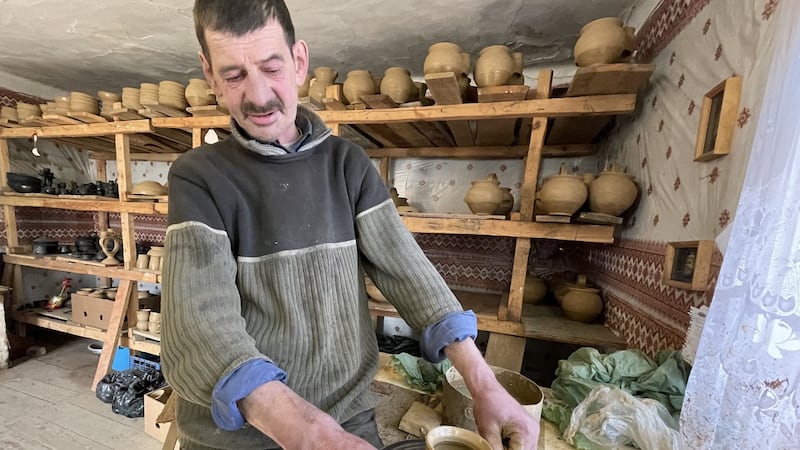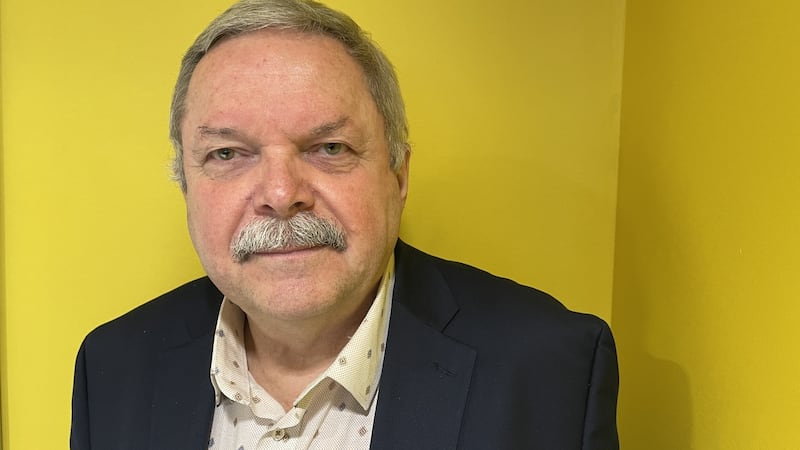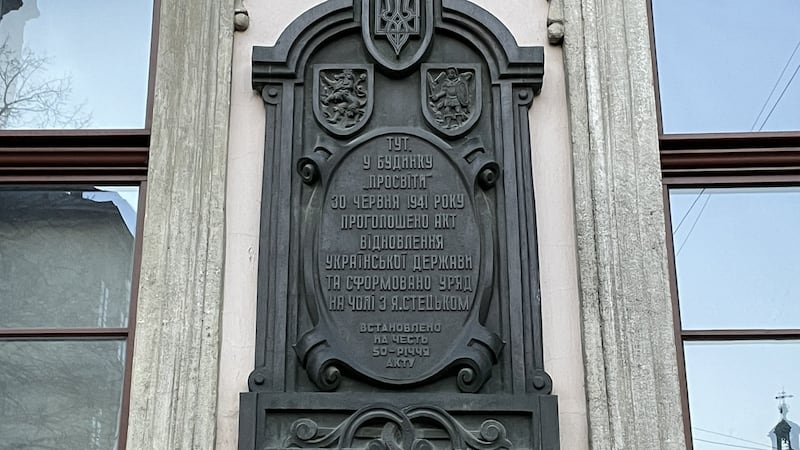There is still a crust of snow in the wooded hills of western Ukraine and an icy seal around the trapdoor of a hideaway in the village of Havarechchyna.
"Many people here were in the Ukrainian Insurgent Army [UPA] and many of them died. They would hide in places like this when the Russians or Germans were looking for them," says our guide, who wears the uniform of the 1940s guerrilla force.
“Locals helped the UPA, including my granddad, and that would get you a death sentence if you were caught,” he explains, hauling open the hatch of a bunker where he says a UPA fighter shot himself when surrounded by the Soviet secret police in 1947.
“The forests and hills of this area were a perfect place for the UPA to hide and to fight,” he adds. “I never thought that new battles might be coming here.”
The local man, one of only about 20 people who now live in Havarechchyna, usually makes a modest living recounting UPA history to parties of schoolchildren and to tourists who visit the village for its traditional black ceramics, which are well known in Ukraine.
Now he wonders whether he will have to swap his UPA uniform and period German and Soviet guns for their modern equivalents, to fight a Russian invasion that has already killed thousands of Ukrainians and displaced 10 million – a quarter of the country’s population.
He confides that he has a semi-automatic rifle and ammunition hidden away "just in case" and has signed up to a local unit of the territorial defence force, which Ukraine says more than 100,000 civilians have joined nationwide since Russia invaded on February 24th.
In an afterthought, as if suddenly remembering UPA tradecraft, he asks that he and the village potter be referred to only by their noms de guerre: “Hroza” (Thunder”) for him, and for his friend the more prosaic “Honchar” (“Potter”).

All Ukrainians are now learning routines that were grimly familiar to previous generations: the sound of air-raid sirens; nights spent sheltering in basements; sudden farewells to loved ones who are going to fight, fleeing to safety, or who died in battle or under the rubble of a bombed home.
Vladimir Putin is only the latest Russian leader to try to crush Ukraine's independence, and his claim to be "denazifying" this pro-western democracy is based on his own distorted and self-serving view of its past and present, and the role played in both by the UPA.
Famine
After the first World War, Ukrainian attempts to carve out a sovereign state from the wreckage of the Russian and Habsburg empires failed, and almost all of today's Ukraine came to be ruled by the Soviet Union and Poland for most of the 1920s and 1930s.
About four million Ukrainians in Kremlin-controlled areas died in 1932-3 in what is known as the Holodomor, a famine caused by Josef Stalin’s forced collectivisation of farmland, which particularly targeted the anti-Soviet Ukrainian peasantry.
During the same decade, hundreds of thousands of Ukrainians were executed and sent to Gulag prison camps during Stalin’s purges of perceived enemies, including leading intellectuals who harboured dreams of an independent Ukraine.
To the west, Poland's discrimination against its Ukrainian community became harsher through the 1930s in response to terror attacks and political assassinations by the Organisation of Ukrainian Nationalists (OUN), led most prominently by Stepan Bandera.
When Adolf Hitler invaded the Soviet Union in 1941, Bandera and his ultra-nationalist faction of the OUN sided with Germany in the hope that it would drive Soviet forces to the east and permit the creation of a sovereign Ukraine.
Bandera’s supporters were among German forces that took Lviv, the main city in western Ukraine, from the retreating Red Army on June 29th, 1941, and the next day they announced the re-establishment of Ukrainian independence.
Despite assuring the Nazis that this nascent Ukrainian government would be their ally, many OUN leaders were swiftly arrested, and Bandera was placed in a concentration camp until 1944.
The UPA was officially formed in 1942 as the military wing of the underground OUN political movement, and its tens of thousands of fighters attacked both Nazi and Red Army troops and formed temporary alliances of convenience, most often with the Germans.
Members of the UPA have always been lionised in western Ukraine for waging guerrilla war against the Soviets until the late 1940s, and for holding out in smaller units until the mid-1950s; UPA members played key roles in major Gulag uprisings, and Bandera survived in Germany until 1959, when a KGB killer sprayed him with cyanide.
“There was no hope of victory,” says Hroza, “but they never gave up.”
Yet some Bandera supporters also joined Nazi police and military units and helped them carry out the Holocaust, and in 1943-4 the UPA massacred about 100,000 Polish civilians in a bid to “ethnically cleanse” what they hoped would become Ukrainian lands.
Propaganda
"I was raised with my parents' memories of the UPA ... My mum told me that the best young men in the village went to that army. She remembered their names and their faces," says Myroslav Marynovych, vice-rector of the Ukrainian Catholic University in Lviv.

"So they were my heroes – but not all of them," adds the former dissident, who spent a decade in a Russian prison camp and exile in Kazakhstan for "anti-Soviet activities".
“This was a crime,” he says of the UPA’s ethnic cleansing. “I acknowledged that and signed many petitions to Poles asking them for forgiveness.”
The Soviets tried to discredit as “fascist” the entire Ukrainian independence movement, and that of other eastern European nations that resented Kremlin rule, and Moscow’s propaganda demonised Bandera as the embodiment of Nazi-collaborationist treachery.
Putin dusted off this trope after Ukraine’s 2014 Maidan revolution, when Russia’s state media laid the groundwork for its occupation of Crimea and proxy war in eastern Ukraine by convincing many people in those regions that bloodthirsty “Banderites” were coming from western Ukraine to kill them. Eight years on, Russia now claims to be in the process of “de-nazifying” its pro-EU, democratic neighbour.
The reality is not that Ukraine has succumbed to racist ideology – its president, Volodymyr Zelenskiy, is a Russian-speaking descendant of Holocaust survivors, and far-right parties have fared abysmally in recent elections – but that Ukrainians have united as never before to defend the independence that UPA fought for in its day.
A nationalist greeting of a century ago – “Glory to Ukraine, glory to the heroes!” – is now ubiquitous here, and is becoming a favourite phrase for western politicians and celebrities who want to show support for the country, as Putin bombards its largely Russophone eastern and southern cities where he expected a warm welcome.
"In Putin's version [of the world] there is no place for independent Ukraine," says Marynovych, who founded the Ukrainian chapter of Amnesty International in 1991.
“Our democracy is a challenge to him. It is not ideal, but it is still a democracy. He proposed his model of dictatorship as the only possible model for all eastern Slavs – Ukrainians, Belarusians and Russians. We didn’t agree, so we had to pay the price. His idea was to destroy this democracy,” he explains.
“Putin also wants to ‘collect’ what he sees as Russian lands, and you cannot imagine a Russian empire without Ukraine. Kyiv is in Ukrainev... and it is the epicentre of legitimisation of the Russian empire. So we are pre-destined to war,” Marynovych (73) adds.
“We cannot find a golden mean between independent Ukraine and imperialistic, dictatorial Russia. I understand the world wants to say: ‘Ceasefire, let’s establish peace!’ But no – the world must choose whether to tell Ukraine to submit to the Russian empire, or to defend modern, democratic values and support Ukraine in its fight for independence.”
‘Construction of lies’
Marynovych finally returned to western Ukraine from prison and exile in April 1987, a decade after his arrest, and over the next five years saw the Soviet Union lose its empire in eastern Europe and then crumble into 15 independent republics.
“We former dissidents and political prisoners were absolutely sure it would all collapse, because the construction of lies was so awful and so big,” he recalls.
“Now I’m sure Putin’s regime will collapse, because again the construction of lies is so enormous: here we are, supposedly in this awful fascist and Nazi country that persecutes the Russian-speaking population – when Putin is actually killing them.”

In Havarechchyna, Hroza pours homemade plum brandy and raises a toast to victory.
“I don’t think Putin will dare come to western Ukraine because he knows he would have huge losses here. But if he does, it will be like a continuation of 1945,” he says, predicting a merciless guerrilla war.
“The Ukrainian nation will survive, it has been cemented by this. We lived well and someone came to steal from us, to hurt us. Even if you were pro-Russian before you won’t be when your house is destroyed ... People who liked Putin and those who hated him are dying now, it makes no odds – and how could anyone like him when he’s killing children?”
Up the hill, Honchar sits at his wheel and shapes a cup from sand-coloured clay that will turn traditional Havarechchyna black when fired in a pit behind his workshop.
It feels almost distasteful to mar the peace of the village with talk about a war that seems so remote. But the previous day 35 people were killed and more than 130 injured in a Russian missile strike on a base 120km from here, in the first major attack of the invasion on western Ukraine.
Honchar (55) is working away quietly at his wheel, as he has for 30 years, when a military helicopter suddenly clatters over the village, quickly followed by three more.
No, he says, that has never happened before. And he has no idea when tourists will come back to Havarechchyna to buy the ceramics that his family has made for generations.
“Who knows now?” he asks. “We are all just waiting for victory.”


















